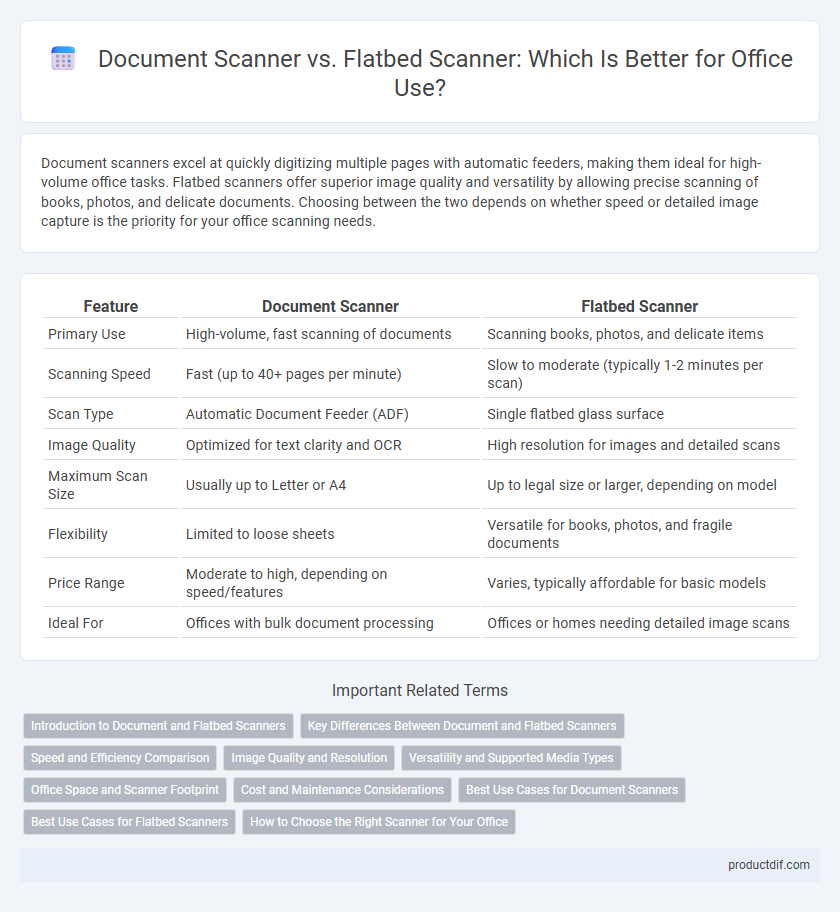Document scanners excel at quickly digitizing multiple pages with automatic feeders, making them ideal for high-volume office tasks. Flatbed scanners offer superior image quality and versatility by allowing precise scanning of books, photos, and delicate documents. Choosing between the two depends on whether speed or detailed image capture is the priority for your office scanning needs.
Table of Comparison
| Feature | Document Scanner | Flatbed Scanner |
|---|---|---|
| Primary Use | High-volume, fast scanning of documents | Scanning books, photos, and delicate items |
| Scanning Speed | Fast (up to 40+ pages per minute) | Slow to moderate (typically 1-2 minutes per scan) |
| Scan Type | Automatic Document Feeder (ADF) | Single flatbed glass surface |
| Image Quality | Optimized for text clarity and OCR | High resolution for images and detailed scans |
| Maximum Scan Size | Usually up to Letter or A4 | Up to legal size or larger, depending on model |
| Flexibility | Limited to loose sheets | Versatile for books, photos, and fragile documents |
| Price Range | Moderate to high, depending on speed/features | Varies, typically affordable for basic models |
| Ideal For | Offices with bulk document processing | Offices or homes needing detailed image scans |
Introduction to Document and Flatbed Scanners
Document scanners specialize in rapidly converting multi-page documents into digital files, often featuring automatic document feeders (ADF) for efficient batch scanning. Flatbed scanners capture high-resolution images of single sheets, photos, or delicate materials by placing them on a glass surface, making them ideal for detailed scanning and archiving. Both scanner types support varied office needs, with document scanners enhancing productivity in volume scanning and flatbed scanners excelling in precision and image quality.
Key Differences Between Document and Flatbed Scanners
Document scanners specialize in rapidly processing multiple pages with automatic document feeders, making them ideal for high-volume office tasks. Flatbed scanners provide superior image quality and versatility by scanning books, photos, and irregular objects on a glass surface. Choosing between these scanners depends on the balance of speed, image resolution, and the types of originals needing digitization.
Speed and Efficiency Comparison
Document scanners excel in speed with automatic feeders capable of processing up to 60 pages per minute, ideal for high-volume office tasks. Flatbed scanners offer detailed image capture but operate slower, requiring manual placement of each document, which reduces efficiency in busy environments. For fast, efficient digitization, especially of multi-page documents, document scanners are the preferred choice in office supply solutions.
Image Quality and Resolution
Document scanners typically offer higher scanning speeds with resolutions ranging from 300 to 600 DPI, making them ideal for digitizing text-heavy documents swiftly, while flatbed scanners provide superior image quality and resolution, often exceeding 1200 DPI, which captures intricate details for photos and delicate materials. Flatbed scanners excel in color accuracy and depth, delivering richer image reproduction vital for graphic-intensive office tasks, whereas document scanners prioritize efficiency over exceptional image fidelity. Selecting between the two depends on the need for high-resolution image capture versus fast, bulk document processing in professional office environments.
Versatility and Supported Media Types
Document scanners excel in speed and efficiency, supporting high-volume batch scanning of standard paper sizes, making them ideal for multi-page documents and receipts. Flatbed scanners offer greater versatility, accommodating a wider range of media types such as books, photos, fragile documents, and irregularly shaped items, with high-resolution scanning capabilities. Businesses requiring diverse media handling benefit from flatbed scanners, while those prioritizing rapid document digitization prefer document scanners.
Office Space and Scanner Footprint
Document scanners feature a compact, vertical design that maximizes office space by minimizing the scanner footprint, ideal for environments with limited desk area. Flatbed scanners require a larger, horizontal surface, occupying significant space and best suited for offices with ample room for bulky equipment. Selecting a document scanner optimizes workspace efficiency, while flatbed scanners provide versatility at the cost of increased footprint.
Cost and Maintenance Considerations
Document scanners generally offer a lower upfront cost and reduced maintenance compared to flatbed scanners due to their simpler design and faster scanning capabilities. Flatbed scanners often involve higher initial investment and more frequent maintenance, including calibration and cleaning, to preserve image quality for detailed or delicate documents. Choosing between the two depends on balancing budget constraints with the required scanning volume and image precision in office supply procurement.
Best Use Cases for Document Scanners
Document scanners excel at rapidly digitizing large volumes of paper documents, making them ideal for office environments that require efficient handling of contracts, invoices, and multi-page reports. Their automatic document feeders (ADFs) streamline batch scanning, reducing manual effort and increasing productivity compared to flatbed scanners. Document scanners also offer advanced features like duplex scanning and OCR integration, enhancing document management and searchability in professional settings.
Best Use Cases for Flatbed Scanners
Flatbed scanners excel at capturing high-resolution images of delicate or bulky documents, such as photographs, books, and artwork, making them ideal for archival purposes. Their ability to scan thick materials without damage and produce detailed, accurate reproductions suits professional office environments requiring precise image quality. Flatbed scanners also handle uneven surfaces and various media types more effectively than document scanners, enhancing versatility in specialized scanning tasks.
How to Choose the Right Scanner for Your Office
Choosing the right scanner for your office depends on your specific needs, with document scanners excelling in speed and handling high volumes of single or double-sided pages efficiently. Flatbed scanners are ideal for scanning fragile documents, books, or photos, providing high-resolution images and versatility for various media types. Evaluate your office's document types, scanning volume, and image quality requirements to determine whether a fast document feeder or a high-quality flatbed interface better suits your workflow.
Document Scanner vs Flatbed Scanner Infographic

 productdif.com
productdif.com